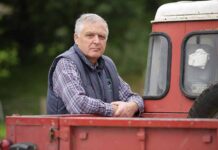The preliminary results of the June 2016 Agricultural Census have been released by the Department of Agriculture, Environment and Rural Affairs.
 The statistics are compiled from a survey of farm businesses augmented by administrative data. The preliminary results were based on the first 9,000 returns and, whilst they should give an indication of the main trends, are liable to be amended in the light of returns received and processed later. Final results will be published in November 2016 by which time all returns from farmers will have been processed.
The statistics are compiled from a survey of farm businesses augmented by administrative data. The preliminary results were based on the first 9,000 returns and, whilst they should give an indication of the main trends, are liable to be amended in the light of returns received and processed later. Final results will be published in November 2016 by which time all returns from farmers will have been processed.
The main changes between June 2015 and June 2016 are:
Cereals: The area of cereals grown increased by 2% to 33,600 ha with winter wheat, winter barley and oats all increasing in 2016. Spring barley fell by 3% but still remains the most popular cereal crop with 15,200 ha planted across Northern Ireland.
Other crops: The area in other field crops is 4% lower than last year, which is partly due to a reduction in the areas planted under arable crop silage and forage maize. The area of arable crop silage fell by 5% to 3,100 ha, whereas, the area of forage maize fell by 8% to 1,400ha. This fall in the forage maize area continues a downward trend that began in 2008 when 3,500 ha was grown. The area of potatoes increased by 4% to 3,700 ha, a slight recovery from 2015 which had the lowest area ever recorded for the crop.
Cattle: Total cattle numbers were 3% higher than in June 2015.The number of dairy cows increased by 2% to 317,100 head, which is an all time high. The number of beef cows increased by 4% to 269,700.
Sheep: There was a 1% rise in the number of breeding ewes compared with 2015. Numbers have fluctuated in recent years, falling to a 20 year low of 876,000 in 2010 before increasing to 950,100 this year, which is the highest level since 2007. Lamb numbers have increased by 2% which links in with the increase in ewe numbers. Overall, the total number of sheep recorded surpassed 2 million which again is a level not seen since 2007.
Pigs: In comparison with 2015, sow numbers increased by 2% to 39,100, whereas, the overall pig herd was 4% larger. Most pig categories are showing an upward trend but the growth in the number of fattening pigs has caused the most increase in total numbers.
Poultry: Laying birds recorded for the 1 June 2016 increased by 20% to 3.8 million birds while broiler poultry numbers increased by 4% at that date. The laying bird population has shown strong growth since 2013 and this is partly due to new producers who have entered the industry.
Farmers and workers: The size of the agricultural labour force decreased by 1% per cent from the previous year to 47,400. Within this, the number of farmers decreased by 2% to 29,500 due to decreases in both the full-time and part-time farmer categories. In terms of other full-time workers, both paid and unpaid categories showed a decrease of 5% compared to 2015.
www.daera-ni.gov.uk/publications/statement-compliance-pre-release-access-official-statistics-order


























